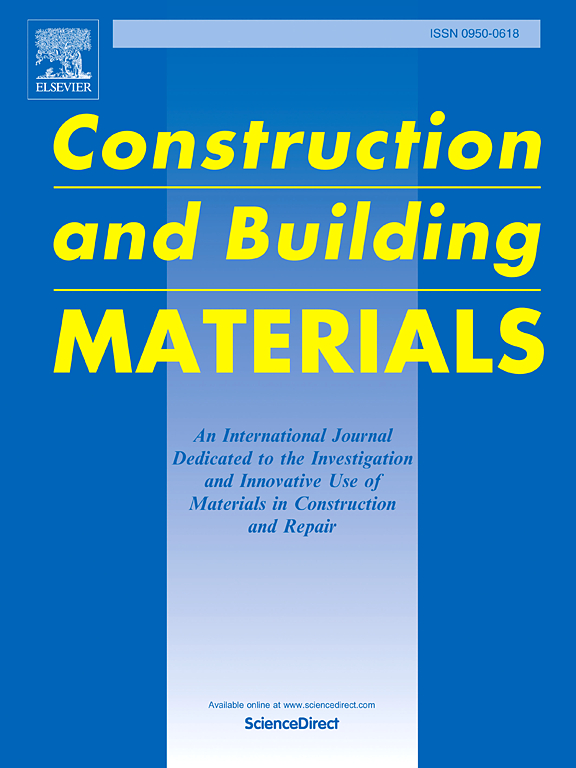Eco-friendly cement mortar production using rice husk ash and oyster seashell powder: A comprehensive study of mechanical, durability and life cycle properties
IF 7.4
1区 工程技术
Q1 CONSTRUCTION & BUILDING TECHNOLOGY
引用次数: 0
Abstract
This study develops eco-friendly cement mortar by synergistically combining rice husk ash (RHA) and oyster calcinated seashell powder (OCSP), leveraging their complementary properties to enhance mechanical and durability performance and sustainability, offering a novel solution for sustainable construction. Mechanical properties, including compressive, splitting tensile, and flexural strength, were evaluated at 7 and 28 days of water curing. Durability was assessed through sodium sulphate resistance, chloride ion penetration, and freeze-thaw tests. The Life cycle assessment was performed using Simapro software by following European standards. Results revealed that mortar with 15 % RHA and 10 % OCSP exhibited approximately 20 % higher compressive, splitting tensile, and flexural strengths compared to the control sample, though strength properties declined at higher RHA and OCSP contents (20 % and 15 %, respectively). Porosity decreased slightly, with the R15S10 mixture showing the lowest porosity (9.7 %) compared to the control (10.2 %). Durability tests of control sample indicated a 20 % compressive strength loss under sodium sulphate exposure, while the 15 % RHA and 10 % OCSP mixture demonstrated five times greater resistance. The chloride ion diffusion coefficient decreased by about 50 % (from 8 ×10⁻¹² m²/s in the control), and freeze-thaw resistance improved significantly with RHA and OCSP incorporation. Life cycle assessment revealed that RHA and OCSP-based mortar had lower environmental impacts in acidification, eutrophication, climate change, photochemical ozone formation, and resource use. These findings highlight the potential of RHA and OCSP based mortar for urban green building construction, where enhanced durability and reduced environmental impact are critical.
稻壳灰和牡蛎壳粉生产环保水泥砂浆:力学、耐久性和生命周期性能的综合研究
本研究通过稻壳灰(RHA)和牡蛎煅烧贝壳粉(OCSP)的协同作用,开发出环保型水泥砂浆,利用它们的互补特性来提高机械和耐久性性能以及可持续性,为可持续建筑提供了一种新的解决方案。力学性能,包括抗压、劈裂拉伸和抗弯强度,在水固化7天和28天进行评估。通过耐硫酸钠、氯离子渗透和冻融试验来评估耐久性。使用Simapro软件按照欧洲标准进行生命周期评估。结果表明,与对照样品相比,RHA含量为15% %和OCSP含量为10% %的砂浆的抗压、劈裂拉伸和抗弯强度提高了约20% %,尽管RHA和OCSP含量较高(分别为20% %和15% %)时强度性能有所下降。孔隙度略有下降,R15S10混合物的孔隙度最低(9.7 %),而对照组的孔隙度为10.2 %。对照样品的耐久性测试表明,在硫酸钠暴露下,抗压强度损失为20% %,而15 % RHA和10 % OCSP混合物的抗压强度损失是前者的5倍。氯离子扩散系数降低了约50% %(从对照组的8 ×10 -¹²m²/s), RHA和OCSP的加入显著提高了抗冻融能力。生命周期评价表明,RHA和ocsp基砂浆在酸化、富营养化、气候变化、光化学臭氧形成和资源利用等方面的环境影响较低。这些发现突出了RHA和OCSP砂浆在城市绿色建筑建设中的潜力,在这些建筑中,增强耐久性和减少对环境的影响至关重要。
本文章由计算机程序翻译,如有差异,请以英文原文为准。
求助全文
约1分钟内获得全文
求助全文
来源期刊

Construction and Building Materials
工程技术-材料科学:综合
CiteScore
13.80
自引率
21.60%
发文量
3632
审稿时长
82 days
期刊介绍:
Construction and Building Materials offers an international platform for sharing innovative and original research and development in the realm of construction and building materials, along with their practical applications in new projects and repair practices. The journal publishes a diverse array of pioneering research and application papers, detailing laboratory investigations and, to a limited extent, numerical analyses or reports on full-scale projects. Multi-part papers are discouraged.
Additionally, Construction and Building Materials features comprehensive case studies and insightful review articles that contribute to new insights in the field. Our focus is on papers related to construction materials, excluding those on structural engineering, geotechnics, and unbound highway layers. Covered materials and technologies encompass cement, concrete reinforcement, bricks and mortars, additives, corrosion technology, ceramics, timber, steel, polymers, glass fibers, recycled materials, bamboo, rammed earth, non-conventional building materials, bituminous materials, and applications in railway materials.
 求助内容:
求助内容: 应助结果提醒方式:
应助结果提醒方式:


